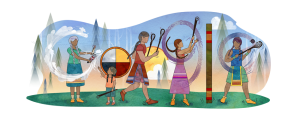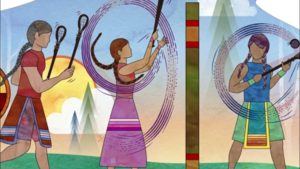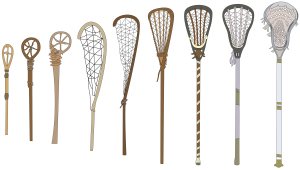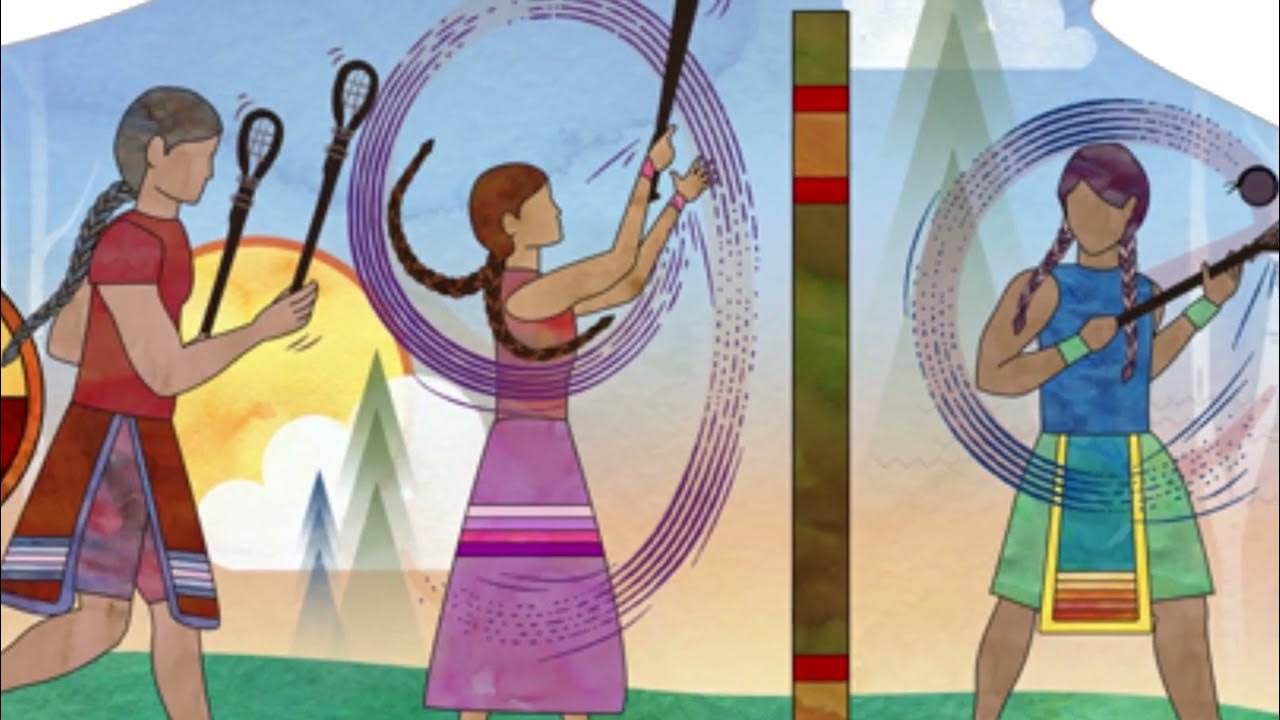What is Indigenous North American stickball?
Indigenous North American stickball is a traditional game played by Indigenous peoples of North America. It is a fast-paced and physically demanding game that combines elements of lacrosse, hockey, and basketball. Stickball is played with a ball and two sticks, and the goal is to score by throwing the ball into the opponent’s goal.

The game has been played for centuries by Indigenous peoples across North America. There are many different variations of stickball, each with its own unique rules and traditions. However, all stickball games share a common emphasis on athleticism, teamwork, and strategy.
Stickball is more than just a game for Indigenous peoples. It is also a cultural and spiritual tradition that has been passed down from generation to generation. Stickball is often played during ceremonies and festivals, and it can be used to teach important lessons about leadership, cooperation, and respect.
In recent years, there has been a renewed interest in stickball among Indigenous communities. This is due in part to the efforts of organizations like the Native American Stickball Association, which are working to preserve and revitalize the game. Stickball is now played by people of all ages and backgrounds, and it is once again an important part of Indigenous culture.
Here are some of the benefits of playing Indigenous North American stickball:
- It is a great way to stay fit and active.
- It teaches teamwork and cooperation.
- It helps build character and leadership skills.
- It is a way to connect with Indigenous culture and traditions.
- It is a fun and challenging game that can be enjoyed by people of all ages.
If you are interested in learning more about Indigenous North American stickball, there are many resources available online and in libraries. You can also contact your local Indigenous community to see if there are any stickball games being played in your area.
Brief history of stickball
Indigenous North American stickball is a Native American game that has been played for centuries. It is a fast-paced and physically demanding game that combines elements of lacrosse, hockey, and basketball. Stickball is played with a ball and two sticks, and the goal is to throw the ball into the opponent’s goal.

The earliest evidence of stickball dates back to 1100 BC in what is now Tennessee. The game was played by many different Native American tribes across North America, each with their own unique rules and traditions. However, all stickball games share a common emphasis on athleticism, teamwork, and strategy.
Stickball was an important part of Native American culture. It was often played during ceremonies and festivals, and it could be used to teach important lessons about leadership, cooperation, and respect. Stickball was also used as a way to settle disputes between tribes.
The arrival of Europeans in North America had a significant impact on stickball. The Europeans saw stickball as a barbaric and violent game, and they tried to suppress it. However, stickball continued to be played by Native Americans, and it eventually became a popular sport among white settlers.
In the early 20th century, stickball began to decline in popularity. This was due to a number of factors, including the assimilation of Native Americans into mainstream American culture, the introduction of new sports like baseball and basketball, and the lack of access to playing fields.
However, there has been a resurgence of interest in stickball in recent years. This is due in part to the efforts of organizations like the Native American Stickball Association, which are working to preserve and revitalize the game. Stickball is now played by people of all ages and backgrounds, and it is once again an important part of Native American culture.
Here are some of the key events in the history of stickball:
- 1100 BC: Earliest evidence of stickball in Tennessee.
- 1600s: Europeans arrive in North America and begin to suppress stickball.
- 1800s: Stickball continues to be played by Native Americans, and it eventually becomes a popular sport among white settlers.
- Early 20th century: Stickball begins to decline in popularity.
- Late 20th century: There is a resurgence of interest in stickball.
- Present day: Stickball is played by people of all ages and backgrounds, and it is once again an important part of Native American culture.
Importance of stickball in Indigenous cultures
Indigenous North American stickball is an important part of Indigenous cultures in North America. It is a traditional game that has been played for centuries, and it has many cultural and spiritual significance.

Stickball is often played during ceremonies and festivals, and it can be used to teach important lessons about leadership, cooperation, and respect. It is also a way to connect with Indigenous culture and traditions.
In some Indigenous cultures, stickball is also used as a way to settle disputes between tribes. The game is seen as a way to resolve conflict peacefully, and it is believed that the winner of the game will be blessed by the spirits.
Stickball is also a way for Indigenous people to express their creativity and athleticism. The game is very fast-paced and physically demanding, and it requires a great deal of skill and coordination.
In recent years, there has been a renewed interest in stickball among Indigenous communities. This is due in part to the efforts of organizations like the Native American Stickball Association, which are working to preserve and revitalize the game. Stickball is now played by people of all ages and backgrounds, and it is once again an important part of Indigenous culture.
Here are some of the specific ways in which Indigenous North American stickball is important to Indigenous cultures:
- It is a way to connect with the past. Stickball is a very old game, and it has been played by Indigenous peoples for centuries. Playing stickball can help Indigenous people to connect with their ancestors and to learn about their traditional culture.
- It is a way to teach important values. Stickball is a game that emphasizes teamwork, cooperation, and respect. It can be used to teach these values to young people, and it can help to build strong communities.
- It is a way to express creativity and athleticism. Stickball is a very physical game, and it requires a great deal of skill and coordination. Playing stickball can help people to develop their physical and mental abilities.
- It is a way to celebrate culture and traditions. Stickball is often played during ceremonies and festivals. It is a way for Indigenous people to come together and to celebrate their culture and traditions.
- It is a way to preserve history. Stickball is a living tradition, and it is passed down from generation to generation. Playing stickball helps to preserve this tradition and to keep it alive for future generations.
Indigenous North American stickball is an important part of Indigenous cultures in North America. It is a traditional game that has been played for centuries, and it has many cultural and spiritual significance. Stickball is a way to connect with the past, to teach important values, to express creativity and athleticism, to celebrate culture and traditions, and to preserve history.
Structure of the article
The structure of an article on Indigenous North American stickball could be as follows:
- Introduction: This section would provide an overview of stickball, including its history, cultural significance, and contemporary relevance.
- History of stickball: This section would discuss the origins of stickball, its evolution over time, and its impact on Indigenous cultures.
- Rules and gameplay: This section would explain the basic rules and gameplay of stickball, including the equipment used, the size of the field, and the number of players.
- Stickball in Indigenous culture: This section would explore the cultural and spiritual significance of stickball, including its role in ceremonies and festivals.
- Regional variations: This section would discuss the different variations of stickball that are played across North America, including the differences in rules, equipment, and gameplay.
- Colonial influence and resilience: This section would discuss the impact of European colonization on stickball, including the suppression of the game and the efforts to revitalize it.
- Stickball in modern times: This section would discuss the contemporary relevance of stickball, including its role in promoting physical activity and community bonding.
- Challenges and preservation efforts: This section would discuss the challenges facing stickball today, including the lack of funding and resources, and the efforts to preserve and revitalize the game.
- Conclusion: This section would summarize the main points of the article and provide a call to action for readers.
This is just a suggested structure, and the specific content of each section would vary depending on the author’s research and perspective. However, this structure provides a good starting point for writing an informative and comprehensive article on Indigenous North American stickball.
Rules and Gameplay
These are just some of the basic rules and gameplay of Indigenous North American stickball. The specific rules and gameplay may vary depending on the tribe or region where the game is being played. However, the basic principles of the game remain the same. Stickball is a fast-paced and physically demanding game that requires a great deal of skill, teamwork, and strategy. It is a traditional game that has been played by Indigenous peoples for centuries, and it continues to be played today as a way to stay active, connect with culture, and build community.

Equipment
The basic equipment for stickball includes:
- A ball made of wood, leather, or rubber
- Two sticks, each about 3 feet long, with a curved end
- Protective gear, such as helmets, pads, and gloves
Field setup
The field for Indigenous North American stickball is typically rectangular, with a goal at each end. The size of the field varies, but it is usually about 100 yards long and 50 yards wide.
Basic rules
The basic rules of stickball are as follows:
- The game is played between two teams of 10-12 players each.
- The goal of the game is to score by throwing the ball into the opponent’s goal.
- Players can use their sticks to hit the ball, but they cannot touch the ball with their hands.
- Players are not allowed to tackle or hit each other.
- The game is played in two halves, with each half lasting about 30 minutes.
Objectives
The objectives of stickball are to:
- Score more goals than the opponent.
- Prevent the opponent from scoring goals.
- Work together as a team to win the game.
Roles of teams, players, and strategies
The teams in stickball are typically divided into offense and defense. The offense is responsible for trying to score goals, while the defense is responsible for preventing the opponent from scoring goals.
The players on each team have different roles. The thrower is responsible for throwing the ball to the other players. The hitters are responsible for hitting the ball with their sticks. The defenders are responsible for preventing the opponent from scoring goals.
The strategies used in stickball vary depending on the team and the situation. However, some common strategies include:
- Passing the ball to create open shots.
- Screening the opponent’s defenders.
- Using teamwork to create scoring opportunities.
Stickball in Indigenous Culture
Indigenous North American stickball is a deeply embedded part of Indigenous culture. It is often played during ceremonies and festivals, and it can be used to teach important lessons about leadership, cooperation, and respect. Stickball is also seen as a way to connect with the past and to preserve Indigenous culture. It is a way for Indigenous people to express their creativity and athleticism, and it is a way to build strong communities.
Connection between stickball and tribal traditions
Indigenous North American stickball is often connected to tribal traditions and beliefs. For example, among the Cherokee, stickball is seen as a gift from the Creator. The game is played to honor the Creator and to give thanks for the blessings of life.
Stickball is also seen as a way to teach important lessons about leadership, cooperation, and respect. The game requires players to work together as a team and to respect each other’s skills and abilities.
Ritualistic and ceremonial aspects of stickball
Indigenous North American stickball is often played during ceremonies and festivals. For example, the Cherokee play stickball during the Green Corn Ceremony, which is a celebration of the harvest. The game is also played during the War Dance, which is a ceremony to prepare for battle.
In some tribes, stickball is played as a way to settle disputes between tribes. The game is seen as a way to resolve conflict peacefully and to build goodwill between the tribes.
Symbolism of stickball in storytelling and art
Indigenous North American stickball is also a common theme in Indigenous storytelling and art. The game is often used to represent courage, strength, and teamwork. Stickball is also seen as a symbol of Indigenous culture and identity.
For example, the Cherokee story of “The Stickball Game” tells the story of a young boy who saves his tribe from a rival tribe by winning a stickball game. The story teaches the importance of teamwork and cooperation.
The art of stickball is also a popular form of expression among Indigenous peoples. Stickball paintings, sculptures, and carvings often depict the game in a realistic or symbolic way. The art of stickball is a way for Indigenous people to express their pride in their culture and heritage.
Regional Variations
There are many different regional variations of Indigenous North American stickball, each with its own unique rules, equipment, and gameplay. Some of the most common regional variations include:
- Eastern stickball: This is the most common variation of stickball, and it is played by many tribes in the eastern United States. The game is played on a rectangular field with two goals at each end. The ball is made of wood or leather, and players use two sticks to hit the ball.
- Western stickball: This variation of stickball is played by many tribes in the western United States. The game is played on a circular field with a single goal in the center. The ball is made of rubber, and players use one stick to hit the ball.
- Iroquois stickball: This variation of stickball is played by the Iroquois Confederacy. The game is played on a rectangular field with two goals at each end. The ball is made of wood, and players use two sticks to hit the ball.
- Lacrosse: This variation of stickball is played by many tribes in Canada and the northeastern United States. The game is played on a rectangular field with two goals at each end. The ball is made of rubber, and players use a long stick with a net at the end to catch and throw the ball.
The rules of stickball also vary from region to region. In some regions, the game is played with a limited number of substitutions, while in other regions, players can be substituted freely. The size of the field and the number of players on each team also vary from region to region.
Stickball is a physically demanding game, and players often wear protective gear, such as helmets, pads, and gloves. The game can be played for fun or competition, and it is often used as a way to build community and promote physical fitness.
Some tribes that are known for their unique stickball traditions include:
- The Cherokee: The Cherokee are known for their stickball game, which is played during the Green Corn Ceremony. The game is a symbol of strength, courage, and teamwork.
- The Iroquois: The Iroquois are known for their lacrosse game, which is played during the Midwinter Ceremony. The game is a symbol of peace and cooperation.
- The Lakota: The Lakota are known for their stickball game, which is played during the Sun Dance. The game is a symbol of strength, courage, and endurance.
- The Ojibwe: The Ojibwe are known for their stickball game, which is played during the Midewiwin ceremony. The game is a symbol of spiritual power and healing.
Colonial Influence and Resilience
The arrival of Europeans in North America had a significant impact on stickball. The Europeans saw stickball as a barbaric and violent game, and they tried to suppress it. They also introduced new sports, such as baseball and football, which competed with stickball for players.
As a result of European colonization, stickball declined in popularity among many Indigenous nations. However, the game was never completely lost. It was kept alive by a few dedicated individuals and communities, and it began to experience a revival in the 20th century.
There are a number of reasons for the revival of stickball. One reason is the growing awareness of the importance of Indigenous culture and heritage. Another reason is the increasing popularity of traditional sports among Indigenous peoples.
Indigenous North American stickball is now played by Indigenous peoples all over North America. It is a way for them to connect with their heritage and to preserve their culture. It is also a way to build community and promote physical fitness.
Stickball is a resilient game. It has survived centuries of colonization and assimilation. It is a symbol of Indigenous strength and resilience. It is also a way for Indigenous peoples to express their identity and to connect with their culture.
Here are some specific examples of how stickball has been used to preserve Indigenous identity:
- The Iroquois Nationals lacrosse team has won numerous championships, including the World Lacrosse Championship in 2014 and 2018. The team’s success has helped to raise awareness of Indigenous culture and heritage.
- The Cherokee Nation has revived its stickball tradition. The game is now played during the Green Corn Ceremony, which is a major festival in the Cherokee community.
- The Lakota Nation has also revived its stickball tradition. The game is now played during the Sun Dance, which is a sacred ceremony for the Lakota people.
Stickball is a living tradition that is still evolving today. It is a way for Indigenous peoples to connect with their past, to build community, and to promote physical fitness. It is also a symbol of Indigenous strength, resilience, and identity.
Stickball in Modern Times
Here is an explanation of the contemporary relevance of stickball in Indigenous communities, its role in promoting physical activity and community bonding, and stickball events, tournaments, and festivals:
Contemporary relevance of stickball in Indigenous communities
Indigenous North American stickball is still played by Indigenous peoples all over North America today. It is a way for them to connect with their heritage and to preserve their culture. It is also a way to build community and promote physical fitness.
The contemporary relevance of stickball in Indigenous communities is multifaceted. The game is a way to:
- Connect with the past: Stickball is a centuries-old tradition that has been passed down from generation to generation. Playing the game can help Indigenous people to connect with their ancestors and to learn about their traditional culture.
- Promote physical activity: Stickball is a physically demanding game that requires a great deal of skill, teamwork, and athleticism. Playing the game can help Indigenous people to stay active and healthy.
- Build community: Stickball is a community-based game that brings people together. Playing the game can help to build relationships and to create a sense of belonging.
- Promote cultural awareness: Stickball is a symbol of Indigenous culture and heritage. Playing the game can help to raise awareness of Indigenous culture and to promote understanding between Indigenous and non-Indigenous peoples.
Role of stickball in promoting physical activity and community bonding
Indigenous North American stickball is a great way to promote physical activity and community bonding. The game is physically demanding and requires a great deal of teamwork. It is also a lot of fun, which makes it a great way to get people together and to build relationships.
Stickball is often played in tournaments and festivals. These events provide a great opportunity for Indigenous peoples to come together and to celebrate their culture. They also provide a platform for Indigenous peoples to share their stories and to learn from each other.
Stickball events, tournaments, and festivals
There are many stickball events, tournaments, and festivals held throughout North America each year. These events are a great way to learn about stickball and to see the game being played at its best.
Some of the most popular stickball events include:
- The Iroquois Nationals Lacrosse Tournament: This tournament is held annually in Onondaga, New York. It is the largest stickball tournament in the world.
- The Cherokee Stickball Tournament: This tournament is held annually in Cherokee, North Carolina. It is a great way to learn about Cherokee culture and heritage.
- The Lakota Stickball Tournament: This tournament is held annually in Pine Ridge, South Dakota. It is a sacred ceremony for the Lakota people.
These are just a few of the many stickball events that are held each year. If you are interested in learning more about stickball, I encourage you to find an event near you and to attend.
Challenges and Preservation Efforts
Here is an explanation of the current challenges facing Indigenous stickball traditions, the initiatives to preserve and revitalize stickball, and the collaborative efforts between tribes and organizations:
Current challenges facing Indigenous stickball traditions
There are many challenges facing Indigenous stickball traditions today. Some of the most common challenges include:
- Lack of funding and resources: Many Indigenous communities lack the funding and resources to support stickball programs and events.
- Lack of access to playing fields: Many Indigenous communities do not have access to suitable playing fields for stickball.
- Declining interest among young people: Stickball is not as popular among young people as it once was. This is due to a number of factors, including the introduction of new sports and the decline of traditional Indigenous culture.
- Lack of awareness: Many people, including Indigenous peoples, are not aware of the importance of stickball to Indigenous culture.
Initiatives to preserve and revitalize stickball
There are many initiatives underway to preserve and revitalize stickball traditions. Some of the most common initiatives include:
- The formation of stickball leagues and organizations: These organizations provide support and resources for stickball programs and events.
- The construction of stickball courts: These courts provide a safe and accessible place to play stickball.
- The development of educational programs: These programs teach people about the history and importance of stickball.
- The promotion of stickball through media and events: This helps to raise awareness of stickball and to attract new players.
Collaborative efforts between tribes and organizations
Many tribes and organizations are working together to preserve and revitalize stickball traditions. These collaborative efforts are essential to the success of these initiatives.
Some of the most common collaborative efforts include:
- Sharing resources: Tribes and organizations can share resources, such as playing fields and equipment.
- Working together to raise funds: Tribes and organizations can work together to raise funds for stickball programs and events.
- Developing joint educational programs: Tribes and organizations can develop joint educational programs to teach people about stickball.
- Promoting stickball through joint events: Tribes and organizations can promote stickball through joint events, such as tournaments and festivals.
FAQs about Indigenous North American Stickball
Here are some FAQs about Indigenous North American stickball:
- What is the history behind Indigenous stickball?
The earliest evidence of stickball dates back to 1100 BC in what is now Tennessee. The game was played by many different Native American tribes across North America, each with their own unique rules and traditions. However, all stickball games share a common emphasis on athleticism, teamwork, and strategy.
- How is stickball played in different tribes?
The rules and gameplay of stickball vary from tribe to tribe. However, the basic game is played with two teams of 10-12 players each. The goal of the game is to score by throwing the ball into the opponent’s goal. Players can use their sticks to hit the ball, but they cannot touch the ball with their hands.
- What is the significance of stickball in modern Indigenous culture?
Stickball is more than just a game for Indigenous peoples. It is also a cultural and spiritual tradition that has been passed down from generation to generation. Stickball is often played during ceremonies and festivals, and it can be used to teach important lessons about leadership, cooperation, and respect.
- How has stickball changed over the years?
Stickball has changed over the years in a number of ways. The rules have been standardized, and the game has become more competitive. Stickball is now played in tournaments and leagues all over the world.
- Are there any professional stickball leagues?
Yes, there are a number of professional stickball leagues, including the Iroquois Nationals Lacrosse team and the Cherokee Stickball Tournament. These leagues provide a forum for Indigenous players to compete at the highest level.
- What role does stickball play in community cohesion?
Stickball plays an important role in community cohesion. The game brings people together from different backgrounds and creates a sense of shared identity. Stickball is also a way to teach important values, such as teamwork and respect.
